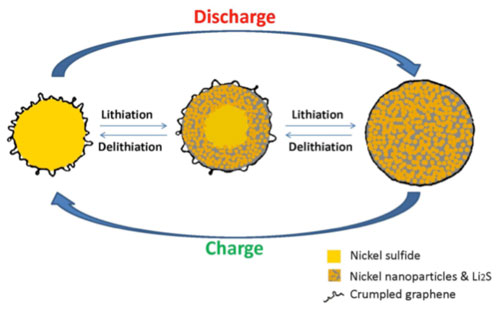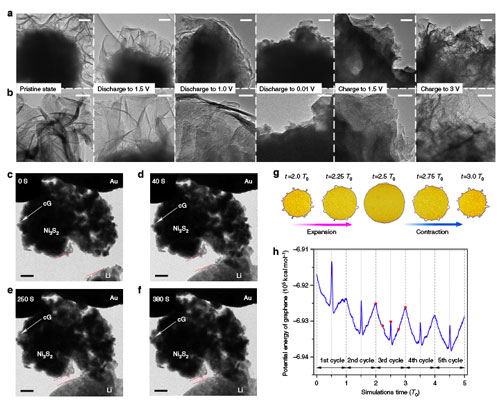| Posted: Aug 06, 2014 | |
Crumpled graphene boosts performance of high-energy lithium storage materials |
|
| (Nanowerk Spotlight) Over the past 20 years, lithium ion (Li-ion) batteries have been widely used as portable power sources in many consumer gadgets, medical devices and space and military technologies. However, limited by their intrinsic intercalation/de-intercalation mechanism, the energy density of today's Li-ion batteries cannot fully satisfy the increased power demand required for electric vehicle batteries. | |
| "Electrode materials based on conversion reaction may be the 'silver bullet', with their high theoretical specific capacity and energy density," Liqiang Mai, a professor at the State Key Laboratory of Advanced Technology for Materials Synthesis and Processing, WUT-Harvard Joint Nano Key Laboratory, at Wuhan University of Technology (WUT), tells Nanowerk. "However, this kind of material suffers from extreme volumetric and structural changes during the charge/discharge process, which has a fatal influence on its cycling performance." | |
| The WUT researchers therefore hypothesized that developing some kind of self-adaptive strain-relaxed and stretchy protective shell would allow them to overcome these limitations. | |
| As a result of their studies, Mai and his group have now published new findings in the August 1, 2014 online edition of Nature Communications ("Self-adaptive strain-relaxation optimization for high-energy lithium storage material through crumpling of graphene"), in which they reported a three-dimensional crumpled graphene-encapsulated nickel sulfide electrode as a superior high-energy lithium storage material. | |
 |
|
| A schematic figure of charge/discharge mechanism of the three dimensional crumpled graphene encapsulated nickel sulfide electrode material. During discharge(lithiation), crumpled graphene encapsulated nickel sulfide expands and the crumple graphene unfolds simultaneously, resulting in nickel nanoparticles and Li2S in the graphene matrix; during charge(delithiation), crumpled graphene refolds and forms pristine-like crumpled graphene encapsulated nickel sulfide. (Image: Mai Research Group, Wuhan University of Technology ) | |
| "Compared with an electrode without crumpled graphene encapsulation, our optimized electrode yields significant improvements, especially in the cycling stability and rate capability," notes Mai. "This enhanced performance is attributed to the 3D framework providing high continuous electron pathway and more free space for charge and mass transfer, and the stabilizing effect of the crumpled graphene based stretchy shell." | |
| According to the team, batteries assembled using the crumpled graphene encapsulated electrode as the working electrode and lithium foil as the counter/reference electrode show greatly improved cycling performances: the battery can cycle for nearly 1,000 cycles and the capacity changes little. Whereas an electrode without crumpled graphene protection lasts no more than 150 cycles. | |
| Prior to this work, his team had already reported that graphene scrolls with tens of micrometers in length greatly improved electrochemical performances in V3O7 and MnO2 nanowires ("Nanowire Templated Semihollow Bicontinuous Graphene Scrolls: Designed Construction, Mechanism, and Enhanced Energy Storage Performance"). | |
| In order to explore the relationship between self-adaptive behavior of the crumpled graphene shell's stabilizing effect and the optimized cycling stability and rate capability of the battery, Mai's group cooperated with researchers from the University of Science and Technology of China (USTC) and the Institute of Physics, Chinese Academy of Sciences (CAS), to take advantage of in situ and ex situ TEM and Molecular Dynamics (MD) simulations to confirm the self-adaptive function of crumpled graphene, both experimentally and theoretically. | |
| "The results are very exciting" says Mai. "Crumpled graphene exhibits a spontaneous folding-unfolding behavior, synchronizing with cyclic expansion-contraction volumetric variation of core materials – which can self-adaptively release strain, buffer electrode volume variations, enhance structure stability, and maintain good electric contact simultaneously." | |
 |
|
| Ex situ and in situ TEM characterizations and MD simulations of the crumpled graphene encapsulated electrode. (a) Low magnification and (b) zoom-in ex situ TEM images of Ni3S2/@crumpled graphene/Ni at different charge/discharge states. The in situ TEM snapshots at (c) 0 s, (d) 40s, (e) 250 s, (f) 380 s. The distance between the two parallel lines indicates the volume expansion during lithiation process. (g) MD snapshots of the graphene encapsulated nanoparticle in the third expansion and contraction cycle. Here, the period of each expansion and contraction cycle is T0. (h) The calculated potential energy of the graphene sheet in a period of five cycles of expansion and contraction. The five red points are corresponding to the five MD snapshots in e. Scale bars, (a) 100 nm, (b) 50 nm, (c?f) 200 nm. (Reprinted with permission by Nature Publishing Group) (click on image to enlarge) | |
| The 3D crumpled graphene encapsulated nickel sulfide electrode was fabricated by a two-step water bath and hydrothermal process. This is the first time a crumpled graphene encapsulated material has been designed and prepared in a wet chemistry environment, which differs from previous methods such as capillary compression or thermal expansion (see for instance: "Crumpled Graphene-Encapsulated Si Nanoparticles for Lithium Ion Battery Anodes"). | |
| "Crumpled graphene structures are promising materials for achieving high energy, high-power density and good safety for advanced lithium battery," concludes Mai. "They also could offer opportunities in other fields, such as material protection, bionic design and drug delivery." | |
 By
Michael
Berger
– Michael is author of three books by the Royal Society of Chemistry:
Nano-Society: Pushing the Boundaries of Technology,
Nanotechnology: The Future is Tiny, and
Nanoengineering: The Skills and Tools Making Technology Invisible
Copyright ©
Nanowerk LLC
By
Michael
Berger
– Michael is author of three books by the Royal Society of Chemistry:
Nano-Society: Pushing the Boundaries of Technology,
Nanotechnology: The Future is Tiny, and
Nanoengineering: The Skills and Tools Making Technology Invisible
Copyright ©
Nanowerk LLC
|
|
|
Become a Spotlight guest author! Join our large and growing group of guest contributors. Have you just published a scientific paper or have other exciting developments to share with the nanotechnology community? Here is how to publish on nanowerk.com. |
|
